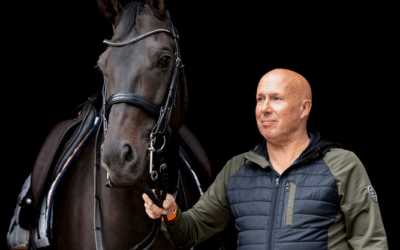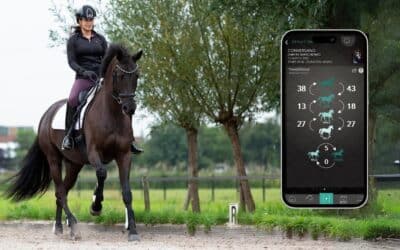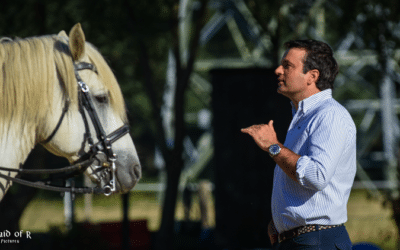Equine Motion Sensor
Equestic SaddleClip
for healthier and more effective training
The Equestic SaddleClip evaluates the quality of a horse’s movements and provides guidance to train more effectively, prevent injuries, and support safe rehabilitation.
Learn from the Founder and Equestic riders about the SaddleClip
Any ride you go on can build your horse up or break him down
You as the rider, trainer or vet should know that…

of riders do not balance the time spent on left and right rein

of horses have over 5% asymmetry on Landing, Push-off or Rhythm

of all trainings are increasing asymmetry with riders not noticing

of riders are not sure they are actually sitting straight in the saddle

only 5% of all trainings have a perfect symmetry of the horse
You can be exceptional
Only some people can feel the 1% deviation of symmetry, precisely track the time of each gait and rein, count all upward/downward transitions and jumps during a training session.
Now anyone can
Thank to Equestic innovations all the above and much more have become possible to track and measure!
With the Equestic SaddleClip – the equine motion sensor any rider can become exceptional at feeling, reading and understanding of a horse movements.
You can level your performance by having insights from the Equestic App and detailed explanation emails with personalized horse motion guidance.
You’ll also receive automatic warnings and notifications of changes which may indicate a potential injury.
Thousands of riders
All level riders from amateurs up to the top levels in all riding disciplines from 65 countries are excited by the SaddleClip’s ease of use, exceptional quality, and reliable support team.
George Williams

GP Dressage Trainer,
USDF president
“It helps me create awareness with my students and enables them to train even more precise. It shows every little deviation you need to work on.”
Emily King

5* eventing rider
European Gold & Silver medalist
“We used it on Jason as he was a little weaker and we wanted to make sure that he built up his muscles as correctly and evenly as possible.”
Dinja van Liere

National Champion 2022,
Tokyo 2021 olympics
“It's amazing how accurate it is. It helps me train even more precisely and find that last 1% of performance improvement.”
Lainey Ashker

USA 5* Event Rider
GP Dressage Gold Medalist
“I have a horse with a big challenge on his right hind. With the SaddleClip I can be sure I don't push him too hard and actually strengthen that leg.”
Tommy Visser

GP Dressage rider
and trainer
“It was invaluable in rehabbing my GP horse Genesis, monitoring every step of the program and making sure we did not build up too fast.”
FEI and USEF Dressage Rules allow Equestic in Competitions
The year 2023 became the turning point for modern technology in Dressage competitions. In a progressive move, the Fédération Equestre Internationale (FEI) and the United States Equestrian Federation (USEF) approved the use of the Equestic SaddleClip, as well as other data-tracking devices, in Dressage competitions up to level 4, USEF Dressage FEI Tests and FEI Dressage CDI Tests.
In 2024 some other National Equestrian Federations updated the regulations allowing Equestic SaddleClip.
Discover best practices, tips and tricks for using the Equestic SaddleClip in dressage, jumping, and rehabilitation on our blog.
Jules Jansen interview – coaching with data
The interview features Jules Jansen, a notable dressage coach, rider, and judge, discussing his experience and use of the Equestic SaddleClip. Jules highlights the device’s utility in monitoring and improving horse performance by analyzing movement, rhythm, regularity, and power. He emphasizes its value in training, allowing for precise adjustments in training regimens and offering insights into the horse’s condition that might not be immediately apparent. Jules also addresses the recent acceptance of sensors in competitions by the FEI and USDF, suggesting it can provide additional insights and improve management during competitive seasons. Despite some reluctance from others in the industry towards technology, Jules advocates for its use to enhance understanding and care for the horse, combining traditional expertise with data-driven insights.
How to improve Transitions: 7 Tips from The Art of Dressage
Post with 7 tips to improve Dressage Transitions and Troubleshoot Common Transition Issues with Equestic SaddleClip
Dressage and Working Equitation training with Nuno Avelar
Interview with Nuno Avelar about the differences in the daily training structure for horses in both Dressage and Working Equitation.
We don’t want you to miss your next winning moment
Your team effort and combined professional experience are incredibly important and innovative technologies are here to make each of you even more successful.












